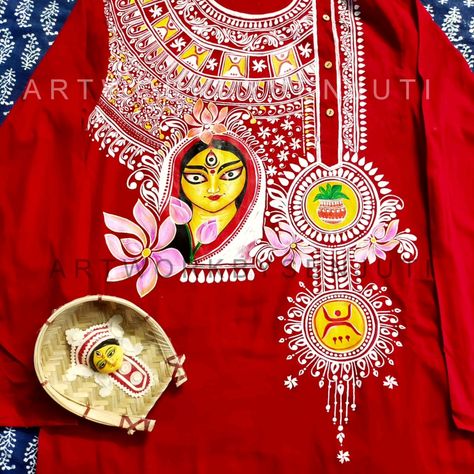Cloth Painting on Punjabi
Punjabi painting, a vibrant and expressive art form, reflects the rich cultural heritage of Punjab, a region known for its colorful festivals, diverse traditions, and deep-rooted spirituality. This art form encompasses various styles and techniques, often integrating elements of folk culture, mythology, and daily life. This class note will explore the history, characteristics, techniques, and contemporary relevance of Punjabi painting.
Historical Background
Origins and Development

Punjabi painting has its roots in the ancient art forms of the region. Early influences can be traced back to the traditional wall paintings of rural Punjab, where artisans would decorate the interiors and exteriors of homes with vibrant colors and motifs. These paintings often depicted scenes from daily life, nature, and folklore.
During the Mughal period (16th to 18th centuries), Punjabi painting began to evolve significantly. The Mughals patronized various art forms, leading to the fusion of Mughal aesthetics with local styles. This period saw the emergence of miniature painting, which involved intricate detailing and vibrant colors, often portraying royal court scenes and historical events.
The Sikh Influence
The arrival of Sikhism in the 15th century also played a pivotal role in the evolution of Punjabi painting. Sikh art is characterized by its spiritual themes, often reflecting the teachings of the Gurus. Artists began to create portraits of Sikh Gurus and scenes from Sikh history, integrating devotional elements into their work. This period emphasized not just aesthetic beauty but also spiritual depth, contributing to the region’s rich artistic tradition.
Characteristics of Punjabi Painting
Themes and Motifs
Punjabi painting is distinguished by its diverse themes, which often draw from the region’s rich folklore, religious narratives, and daily life. Common motifs include:
- Folk Life: Depictions of rural life, including agriculture, festivals, and traditional crafts.
- Nature: Vibrant representations of flora and fauna, showcasing the region’s natural beauty.
- Mythology and Religion: Illustrations of stories from Sikhism, Hinduism, and local legends.
Color Palette
The use of color in Punjabi painting is particularly striking. Artists employ a bold and vibrant palette, using natural pigments derived from plants and minerals. The colors often hold symbolic meanings, such as:
- Red: Symbolizes love and passion.
- Yellow: Represents joy and prosperity.
- Green: Associated with fertility and nature.
These colors are used in a way that enhances the overall vibrancy of the artwork, making it visually captivating.
Techniques
Punjabi painting employs various techniques, which can vary based on regional styles and the intended medium. Some notable techniques include:
- Miniature Painting: This technique involves intricate detailing, often requiring a steady hand and precise brushwork. Miniature paintings are usually done on paper or cloth.
- Murals: In rural areas, large murals are painted on the walls of homes and community centers, often depicting scenes from folklore and daily life.
- Gond Art Influence: In certain regions, Punjabi painting has been influenced by Gond art, which features intricate patterns and a connection to nature.
Styles of Punjabi Painting
Phulkari

Phulkari, meaning “flower work,” is a traditional form of embroidery that originated in Punjab and has a close relationship with painting. While primarily a textile art form, the motifs and patterns of Phulkari are often inspired by the same themes found in Punjabi painting. The vibrant floral patterns create a visual dialogue between textiles and painting, highlighting the importance of color and design in Punjabi culture.
Sikh Miniature Painting
Sikh miniature painting is a distinctive style that emerged during the Sikh period, characterized by its portrayal of historical events, Sikh Gurus, and scenes from daily life. These paintings often incorporate gold leaf and intricate detailing, reflecting the spiritual and cultural richness of Sikhism.
Folk Art
Folk art in Punjab encompasses a range of styles that are deeply rooted in the traditions of rural communities. This art form often features bold colors, simplified forms, and a direct connection to the daily lives of the people. It is usually created by anonymous artisans and is often displayed in homes, festivals, and community gatherings.
Contemporary Punjabi Painting
Revival and Popularity
In recent years, Punjabi painting has experienced a revival, with contemporary artists drawing inspiration from traditional themes while experimenting with modern techniques and styles. This resurgence has led to increased interest in Punjabi art, both within India and globally.
Integration with Modern Art
Contemporary Punjabi artists often integrate traditional motifs with modern concepts, addressing current social issues and personal narratives. This blending of styles allows for a fresh perspective on Punjabi painting, appealing to a wider audience.
Art Festivals and Exhibitions
Art festivals and exhibitions focusing on Punjabi painting have become increasingly common. These events provide a platform for artists to showcase their work and engage with the public. They also foster collaboration among artists, encouraging the exchange of ideas and techniques.
Educational Initiatives
Educational programs aimed at preserving and promoting Punjabi painting are emerging. Workshops and courses teach traditional techniques to new generations, ensuring the continuity of this rich cultural heritage. By engaging young artists, these initiatives help sustain the art form and promote its relevance in contemporary society.
Conclusion
Punjabi painting is a vibrant and dynamic expression of the cultural heritage of the Punjab region. Its rich history, characterized by influences from various periods and cultures, reflects the resilience and creativity of the Punjabi people. Today, as Punjabi painting continues to evolve, it stands as a testament to the enduring power of art in preserving cultural identity and fostering community connections. By appreciating and supporting Punjabi painting, we not only celebrate its aesthetic beauty but also contribute to the preservation of a unique cultural legacy that enriches our collective human experience.

